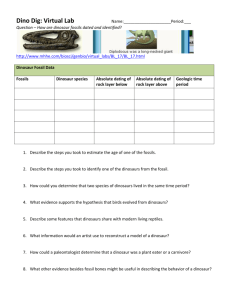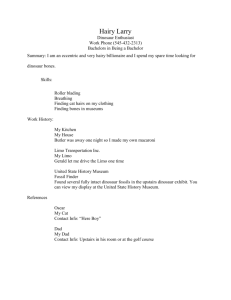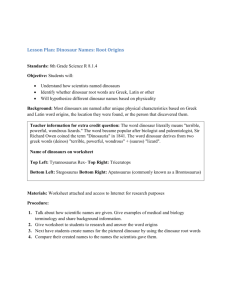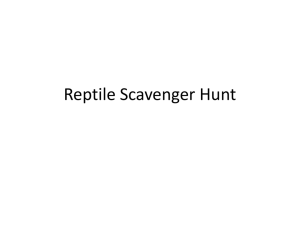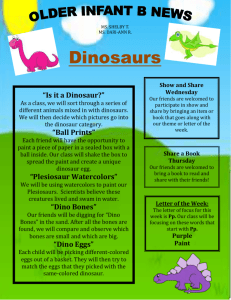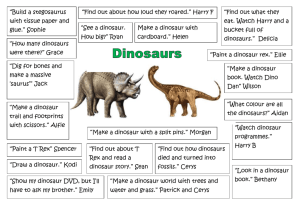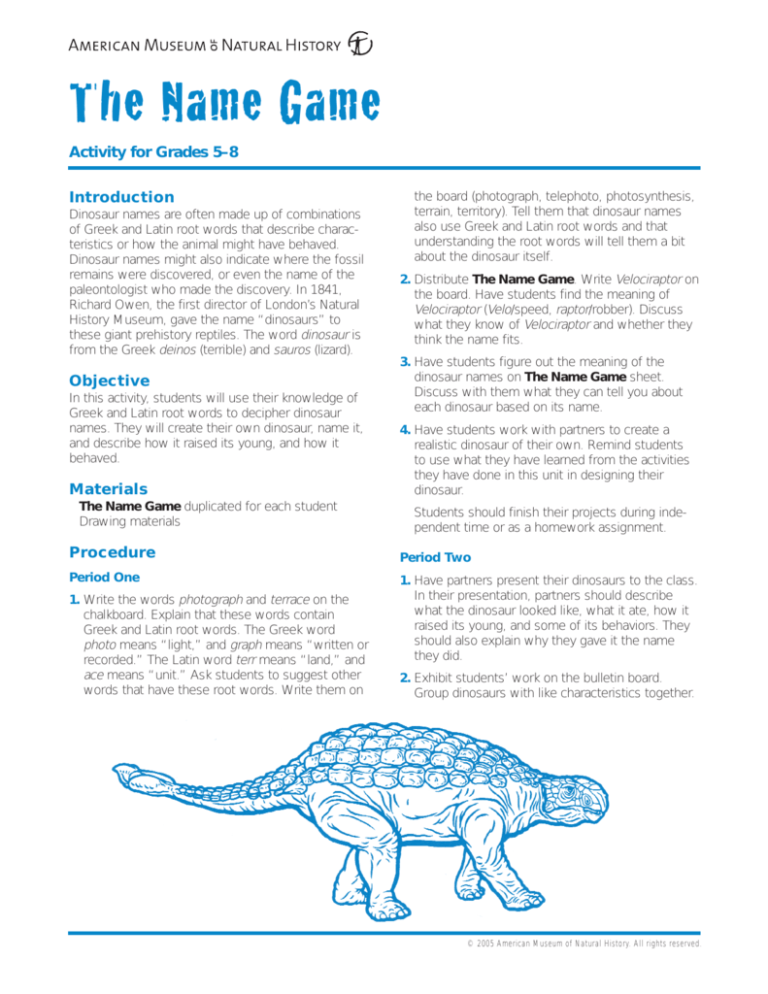
The Name Game
Activity for Grades 5–8
Introduction
Dinosaur names are often made up of combinations
of Greek and Latin root words that describe characteristics or how the animal might have behaved.
Dinosaur names might also indicate where the fossil
remains were discovered, or even the name of the
paleontologist who made the discovery. In 1841,
Richard Owen, the first director of London’s Natural
History Museum, gave the name “dinosaurs” to
these giant prehistory reptiles. The word dinosaur is
from the Greek deinos (terrible) and sauros (lizard).
Objective
In this activity, students will use their knowledge of
Greek and Latin root words to decipher dinosaur
names. They will create their own dinosaur, name it,
and describe how it raised its young, and how it
behaved.
Materials
• The Name Game duplicated for each student
• Drawing materials
the board (photograph, telephoto, photosynthesis,
terrain, territory). Tell them that dinosaur names
also use Greek and Latin root words and that
understanding the root words will tell them a bit
about the dinosaur itself.
2. Distribute The Name Game. Write Velociraptor on
the board. Have students find the meaning of
Velociraptor (Velo/speed, raptor/robber). Discuss
what they know of Velociraptor and whether they
think the name fits.
3. Have students figure out the meaning of the
dinosaur names on The Name Game sheet.
Discuss with them what they can tell you about
each dinosaur based on its name.
4. Have students work with partners to create a
realistic dinosaur of their own. Remind students
to use what they have learned from the activities
they have done in this unit in designing their
dinosaur.
Students should finish their projects during independent time or as a homework assignment.
Procedure
Period Two
Period One
1. Have partners present their dinosaurs to the class.
In their presentation, partners should describe
what the dinosaur looked like, what it ate, how it
raised its young, and some of its behaviors. They
should also explain why they gave it the name
they did.
1. Write the words photograph and terrace on the
chalkboard. Explain that these words contain
Greek and Latin root words. The Greek word
photo means “light,” and graph means “written or
recorded.” The Latin word terr means “land,” and
ace means “unit.” Ask students to suggest other
words that have these root words. Write them on
2. Exhibit students’ work on the bulletin board.
Group dinosaurs with like characteristics together.
© 2005 American Museum of Natural History. All rights reserved.
The Name Game
Name
Date
1. Use the Greek and Latin root words to figure out the dinosaur names below.
allo
anato
ankylo
anuro
apato
baro
bi
brachio
bronto
canthus
cerat, ceros
cephalo
compso
cory
di
dino
diplo
docus
strange
duck
crooked
no tail
deceptive
heavy
two
arm
thunder
spiked, spined
horned
head
pretty
helmet
two
terrible
double
beam
don, dont
drypto
echino
elasmo
gnathus
lana
lepto
macro
maia
mega
micro
mimus
mono
nano
nodo
ops
ornitho
pachy
tooth
wounding
spiked
plated
jaw
wooly
slender
large
good mother
huge
small
mimic
one, single
dwarf
lumpy
face
bird
thick
pacro
ped
plateo
proto
raptor
rex
rhino
saur, saurus
stego
stereo
super
tri
tyranno
ultra
urus
veloci
xeno
xero
ridge
foot
flat
first
robber
king
nose
lizard
roof
twin
superior
three
tyrant
extreme
tail
speedy
strange
dry
a. Brachiosaurus
b. Ankylosaurus
c. Compsognathus
d. Stegosaurus
e. Triceratops
f. Allosaurus
g. Pachycephalosaurus
2. With a partner, create a dinosaur of your own. Use what you have read about dinosaurs and the activities you
have done to help you. When designing your dinosaur think about the following:
a. What did your dinosaur eat? What kind of teeth did it have?
b. What did your dinosaur look like? What kind of skin did it have? What color was it?
c. How did your dinosaur behave?
Draw a picture of your dinosaur. Think of a good name for your dinosaur. Use the Greek and Latin roots to
create the name. Write a paragraph that describes your dinosaur.
© 2005 American Museum of Natural History. All rights reserved.

